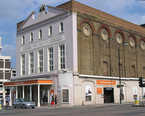EN
history of the theatresupplementtechnical dataHistoric equipmentOld Vic
Rudolph Cabanel
alias Royal Coburg Theatre, Royal Victoria Hall and Coffee Tavern, Royal Victorian Theatre103 The Cut, | Wikipedia, The Theatres Trust, arthurlloyd.co.uk, cinematreasures.org |
| show on the map | http://www.oldvictheatre.com/ |
Important events
(detail)1818 | opening
It opened in May 1818 with a melodramatic spectacle, Trial by Battle; or, Heaven Defend the Right, written and produced by William Barrympre.
(detail)1927 | alteration
The theatre was renovated to the plans of architect F.G.M. Chancellor out of Frank Matcham’s office in 1927. The seating capacity was 1,454, in stalls, dress circle and balcony. The dress circle and balcony are in a horse-shoe shape, supported by iron pillars. The stage is 30 feet deep.
(http://cinematreasures.org/theaters/30783)
(detail)1941 | fire
The theatre was damaged by German bombs, and remained closed until repairs were carried out in December 1950 to the plans of architect Douglas W. Rowntree.
People
History
Additional information
No information has yet been entered
Add information









